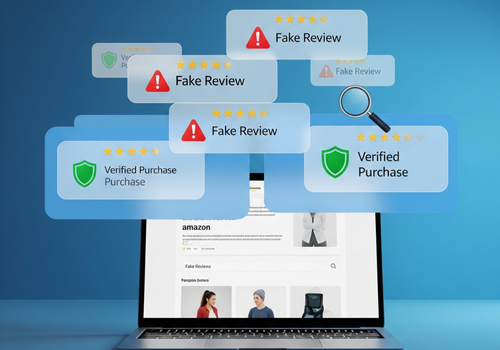How to Spot Fake Reviews on Amazon and Avoid Wasting Money on Products That Look Too Good to Be True
The Problem with Fake Reviews on Amazon
Amazon has become one of the most trusted online marketplaces globally, but that trust is often exploited by unethical sellers. Many low-quality or even counterfeit products on Amazon are propped up by manipulated or completely fabricated reviews. These fake reviews create an illusion of quality and popularity, pushing poor products into the top search results and into shoppers’ carts. Fake reviews can be generated by bots, paid reviewers, or even real customers offered free products or incentives in exchange for positive feedback. This undermines your ability to make informed decisions and increases the risk of receiving a product that doesn’t live up to its promises.
Why Sellers Create Fake Reviews
The competition on Amazon is fierce. Sellers know that star ratings and review volume heavily influence buying behavior. Products with more positive reviews appear higher in search results, get chosen by the Amazon algorithm for “Amazon’s Choice” badges, and often outsell better products that lack flashy feedback. Because of this, many sellers resort to fake review tactics. They may use third-party services that promise “review boosting,” or incentivize buyers with refunds, gift cards, or discounts after a positive review is posted. Some even hijack listings by merging their poor-quality product with a highly-rated, unrelated one. These deceptive practices are widespread and often hard to detect without knowing what to look for.
How to Identify Fake Reviews Using Verified Tools and Patterns
One of the most reliable ways to detect fake reviews is to use tools like Fakespot, ReviewMeta, or browser extensions that analyze review authenticity. These tools assess writing patterns, timing of review submissions, the ratio of verified to unverified purchases, and other indicators of manipulation. However, you can also spot red flags manually. Watch out for clusters of 5-star reviews posted in a short time span, overly generic language that could apply to any product, or repetitive phrases that sound robotic or unnatural. Reviews that don’t describe any specific product features or include vague praise like “Great product!” without further detail are often fake. If a review includes a disclaimer about receiving the product for free or at a discount, approach it with caution. Also, look for unnatural amounts of photos that appear staged or reused across different products.
The Danger of “Review Hijacking” and Merged Listings
One deceptive strategy used by shady sellers is review hijacking — where they merge their product listing with a popular, well-reviewed product to inherit its rating history. For example, you might be shopping for a specific type of supplement, but the reviews mention completely unrelated items like phone chargers or towels. This tactic inflates the seller’s credibility while misleading you with irrelevant reviews. Always scroll down and check the “Product Variations” and “Review Highlights” to see if the feedback actually matches the product you are purchasing. If the review section looks suspiciously disconnected from the item shown in the images or title, it’s likely a hijacked listing.
Spotting Review Patterns That Don’t Add Up
Consistency is a hallmark of authenticity. Real reviews typically reflect a balance of pros and cons, and customer expectations vary. When you see a product with only 5-star reviews and barely any 3- or 4-star ratings, it’s a red flag. Another giveaway is when several reviews are written in broken English but are all posted within the same time frame. If reviews read like a script or contain phrases that seem copied and pasted, that’s another strong indicator of manipulation. In contrast, genuine reviews usually have a natural flow, mention unique use cases, and sometimes include photos that clearly reflect a real user’s experience.
Check Verified Purchase Tags and Reviewer Profiles
Always pay attention to the “Verified Purchase” tag next to reviews. While even those can be manipulated, reviews without it should be taken with extra caution. Click on the reviewer’s profile — if they’ve left hundreds of 5-star reviews for unrelated products over a short period, they may be part of a paid review network. Genuine reviewers usually have a mixed history of positive and negative feedback across a few categories. Their profiles often include a short bio and show purchase activity that reflects actual shopping behavior.
How Fake Reviews Impact Product Rankings and Visibility
Fake reviews don’t just deceive individual buyers — they disrupt the entire Amazon ecosystem. Products with inflated ratings appear higher in search results, receive “Amazon’s Choice” tags, and dominate categories through unethical means. As a result, legitimate brands and safer, more effective products get pushed down the rankings, making them harder for shoppers to find. This is especially dangerous for categories like health supplements, where consumers may unknowingly buy untested or harmful items based solely on star ratings. The manipulation of Amazon’s review system damages consumer trust and leads to wasted money, frustration, and sometimes even health risks.
What Amazon Is Doing — and What It Isn’t
Amazon claims to actively monitor and remove fake reviews, and it has implemented machine learning tools and a review abuse team to handle fraudulent activity. However, the volume of listings and sheer scale of the marketplace means many fake reviews still slip through. Enforcement is inconsistent, and sellers often find ways around detection. Amazon has sued fake review providers, but many operate from overseas and reappear under different names. Ultimately, while Amazon has systems in place, it’s still up to the consumer to stay vigilant and make educated choices.
Conclusion: Be a Smart Shopper — Trust, but Verify
Fake reviews are a growing problem on Amazon, but they don’t have to trick you. With the right tools, awareness, and buying habits, you can learn to filter out the noise and spot red flags before falling for a misleading product. Use review analysis tools like Fakespot and ReviewMeta, check for “Verified Purchase” badges, read reviews carefully for detail and authenticity, and always research the seller. When shopping for health supplements, electronics, or baby care products, the stakes are too high to rely on manipulated ratings. By taking a few extra steps before clicking “Buy Now,” you can avoid wasting money, protect your health, and ensure you’re supporting honest brands that deliver on their promises. The truth is — what looks too good to be true on Amazon often is. But now, you know how to see through the illusion.

